Risks of VBAC: A Systematic Review of Vaginal Delivery Post C-Section
VerifiedAdded on 2023/05/26
|51
|11873
|292
Literature Review
AI Summary
This literature review critically examines the risks associated with vaginal birth after caesarean section (VBAC). It explores factors influencing VBAC success, including maternal and neonatal safety, risk of uterine rupture, and effectiveness of local policies. The review assesses research from 2013-2018, using the PICO framework and GRADE assessment to evaluate the quality of evidence. The aim is to provide insights for safe infant delivery practices, reduce back-to-back caesarean sections, and improve maternal and fetal health outcomes by analyzing available scientific evidence and evidence-based research practices.
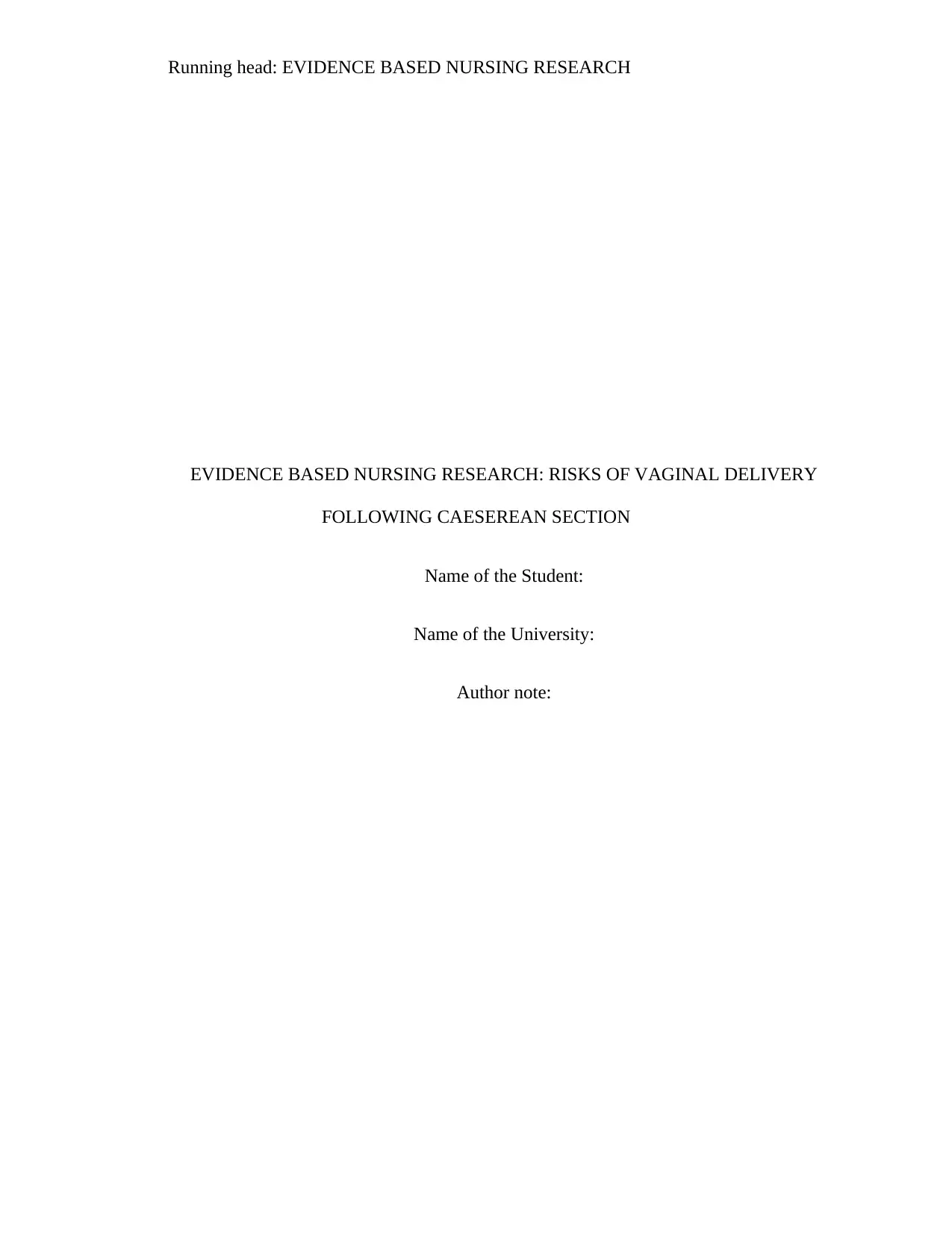
Running head: EVIDENCE BASED NURSING RESEARCH
EVIDENCE BASED NURSING RESEARCH: RISKS OF VAGINAL DELIVERY
FOLLOWING CAESEREAN SECTION
Name of the Student:
Name of the University:
Author note:
EVIDENCE BASED NURSING RESEARCH: RISKS OF VAGINAL DELIVERY
FOLLOWING CAESEREAN SECTION
Name of the Student:
Name of the University:
Author note:
Paraphrase This Document
Need a fresh take? Get an instant paraphrase of this document with our AI Paraphraser
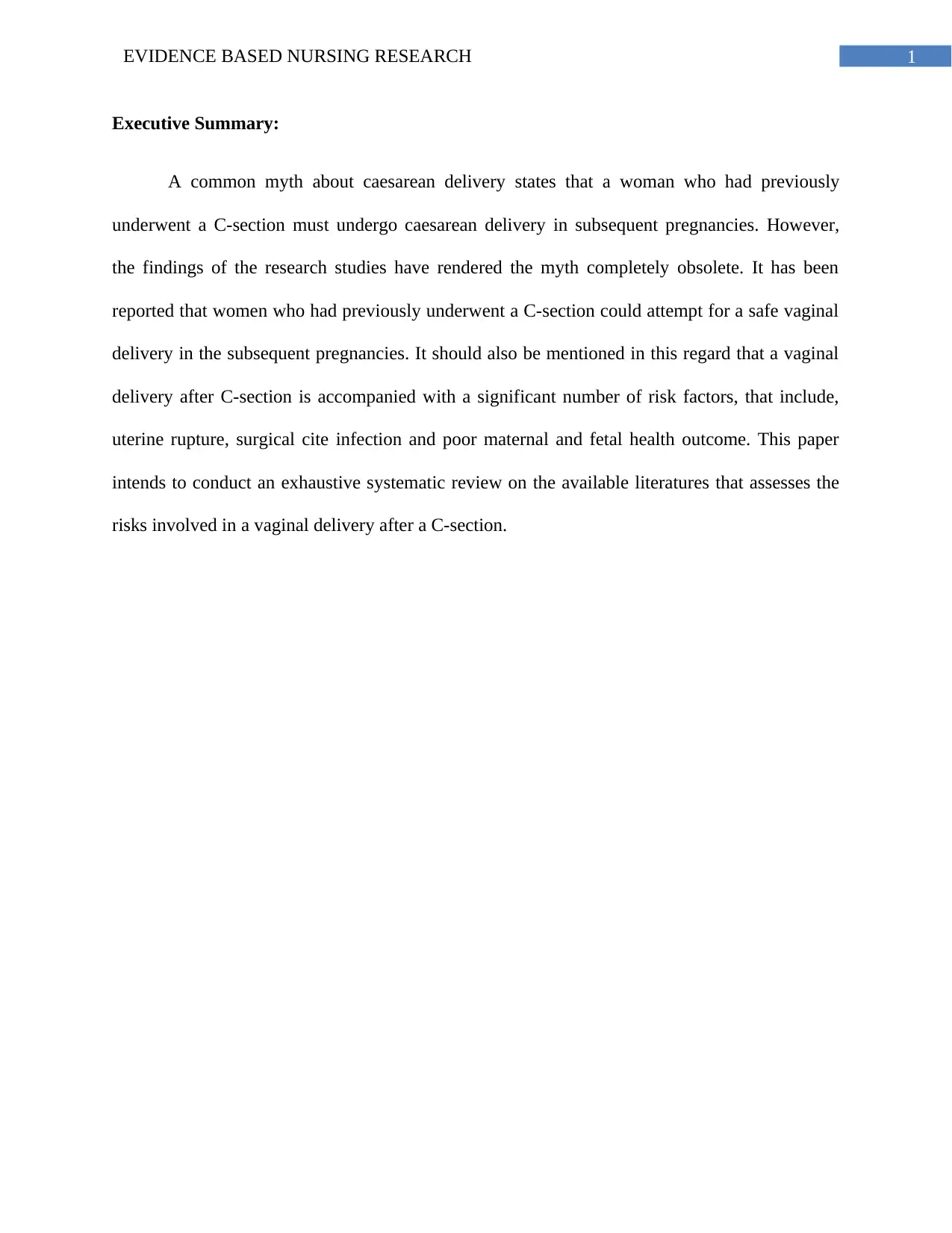
1EVIDENCE BASED NURSING RESEARCH
Executive Summary:
A common myth about caesarean delivery states that a woman who had previously
underwent a C-section must undergo caesarean delivery in subsequent pregnancies. However,
the findings of the research studies have rendered the myth completely obsolete. It has been
reported that women who had previously underwent a C-section could attempt for a safe vaginal
delivery in the subsequent pregnancies. It should also be mentioned in this regard that a vaginal
delivery after C-section is accompanied with a significant number of risk factors, that include,
uterine rupture, surgical cite infection and poor maternal and fetal health outcome. This paper
intends to conduct an exhaustive systematic review on the available literatures that assesses the
risks involved in a vaginal delivery after a C-section.
Executive Summary:
A common myth about caesarean delivery states that a woman who had previously
underwent a C-section must undergo caesarean delivery in subsequent pregnancies. However,
the findings of the research studies have rendered the myth completely obsolete. It has been
reported that women who had previously underwent a C-section could attempt for a safe vaginal
delivery in the subsequent pregnancies. It should also be mentioned in this regard that a vaginal
delivery after C-section is accompanied with a significant number of risk factors, that include,
uterine rupture, surgical cite infection and poor maternal and fetal health outcome. This paper
intends to conduct an exhaustive systematic review on the available literatures that assesses the
risks involved in a vaginal delivery after a C-section.
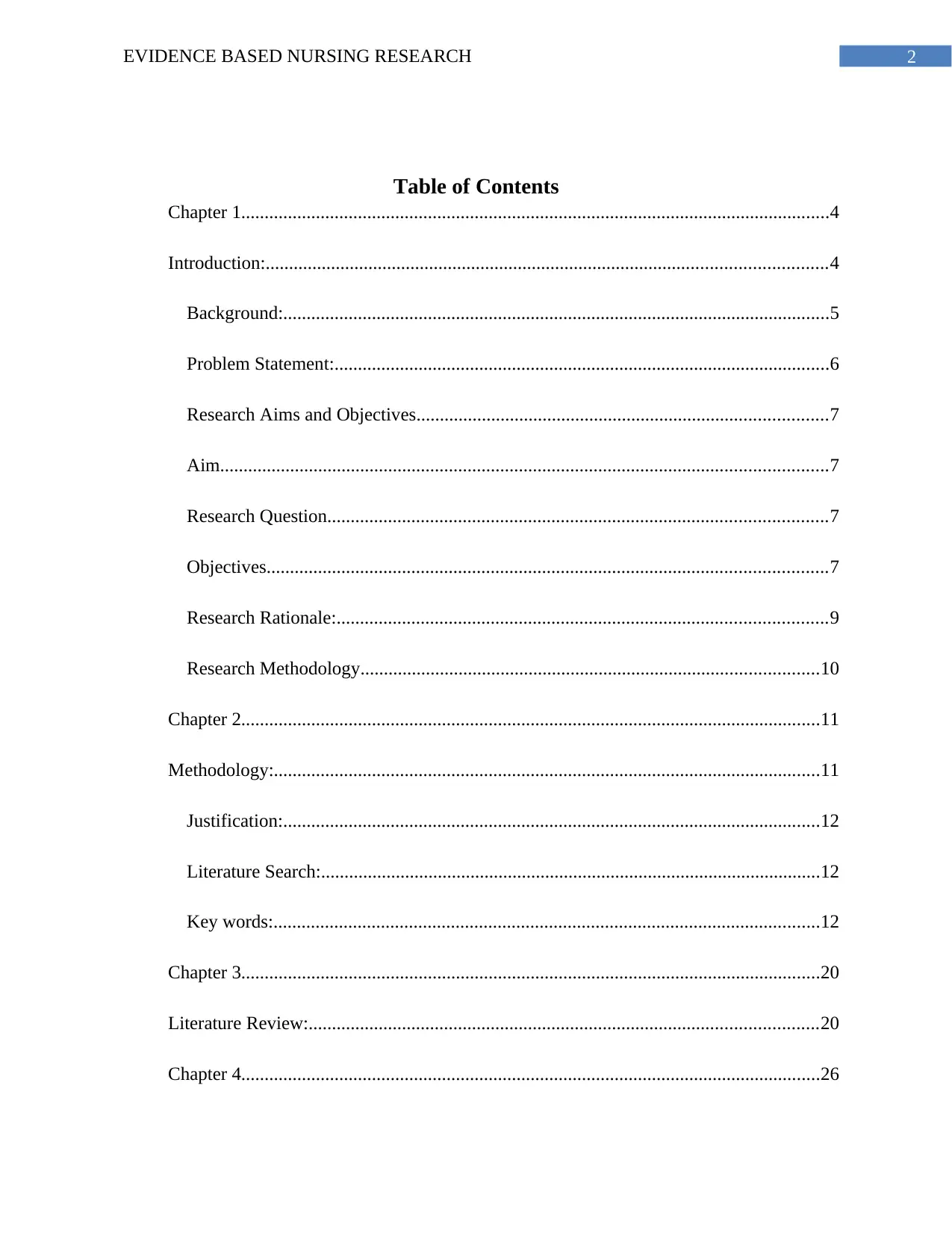
2EVIDENCE BASED NURSING RESEARCH
Table of Contents
Chapter 1..............................................................................................................................4
Introduction:........................................................................................................................4
Background:.....................................................................................................................5
Problem Statement:..........................................................................................................6
Research Aims and Objectives........................................................................................7
Aim..................................................................................................................................7
Research Question...........................................................................................................7
Objectives........................................................................................................................7
Research Rationale:.........................................................................................................9
Research Methodology..................................................................................................10
Chapter 2............................................................................................................................11
Methodology:.....................................................................................................................11
Justification:...................................................................................................................12
Literature Search:...........................................................................................................12
Key words:.....................................................................................................................12
Chapter 3............................................................................................................................20
Literature Review:.............................................................................................................20
Chapter 4............................................................................................................................26
Table of Contents
Chapter 1..............................................................................................................................4
Introduction:........................................................................................................................4
Background:.....................................................................................................................5
Problem Statement:..........................................................................................................6
Research Aims and Objectives........................................................................................7
Aim..................................................................................................................................7
Research Question...........................................................................................................7
Objectives........................................................................................................................7
Research Rationale:.........................................................................................................9
Research Methodology..................................................................................................10
Chapter 2............................................................................................................................11
Methodology:.....................................................................................................................11
Justification:...................................................................................................................12
Literature Search:...........................................................................................................12
Key words:.....................................................................................................................12
Chapter 3............................................................................................................................20
Literature Review:.............................................................................................................20
Chapter 4............................................................................................................................26
⊘ This is a preview!⊘
Do you want full access?
Subscribe today to unlock all pages.

Trusted by 1+ million students worldwide
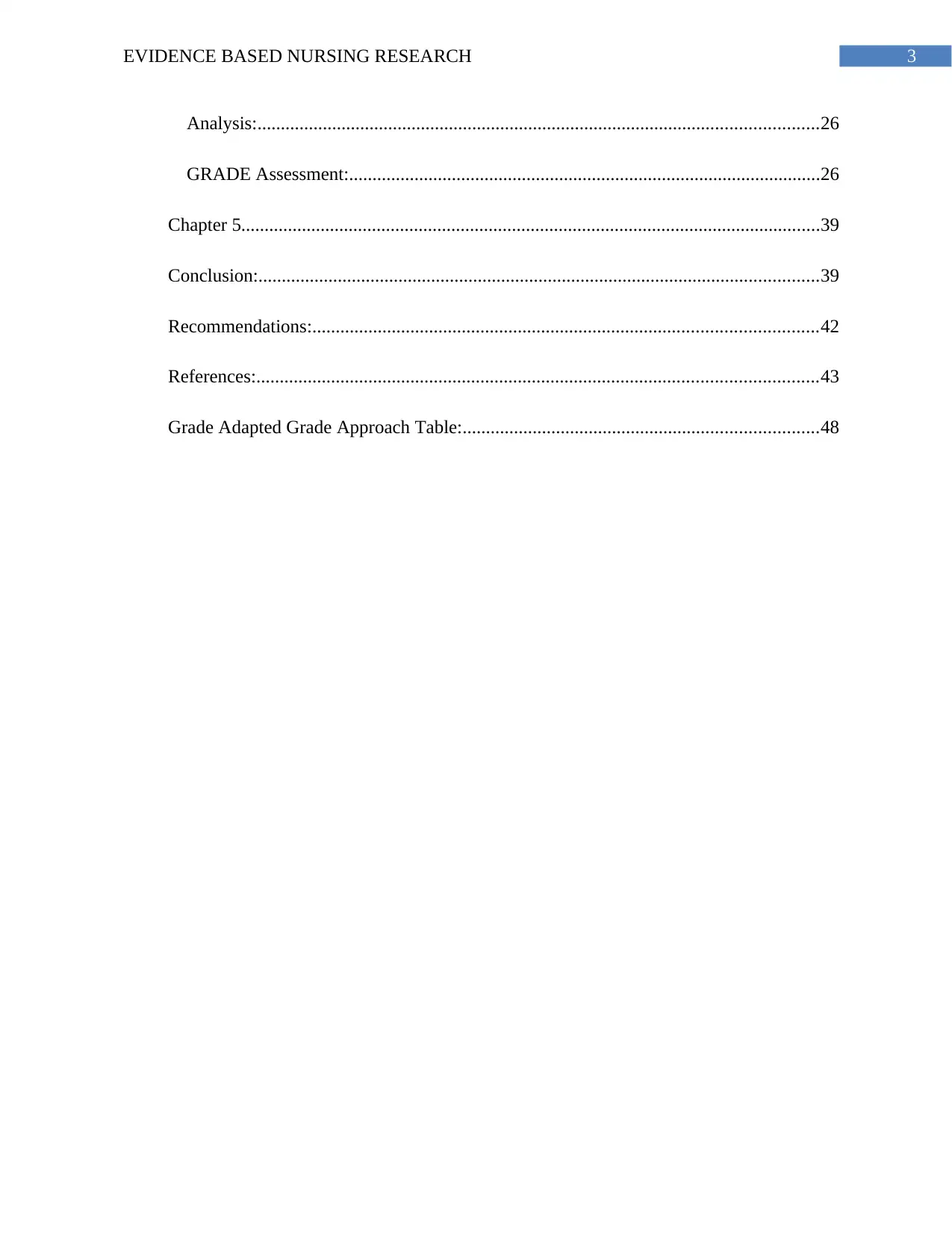
3EVIDENCE BASED NURSING RESEARCH
Analysis:........................................................................................................................26
GRADE Assessment:.....................................................................................................26
Chapter 5............................................................................................................................39
Conclusion:........................................................................................................................39
Recommendations:............................................................................................................42
References:........................................................................................................................43
Grade Adapted Grade Approach Table:............................................................................48
Analysis:........................................................................................................................26
GRADE Assessment:.....................................................................................................26
Chapter 5............................................................................................................................39
Conclusion:........................................................................................................................39
Recommendations:............................................................................................................42
References:........................................................................................................................43
Grade Adapted Grade Approach Table:............................................................................48
Paraphrase This Document
Need a fresh take? Get an instant paraphrase of this document with our AI Paraphraser
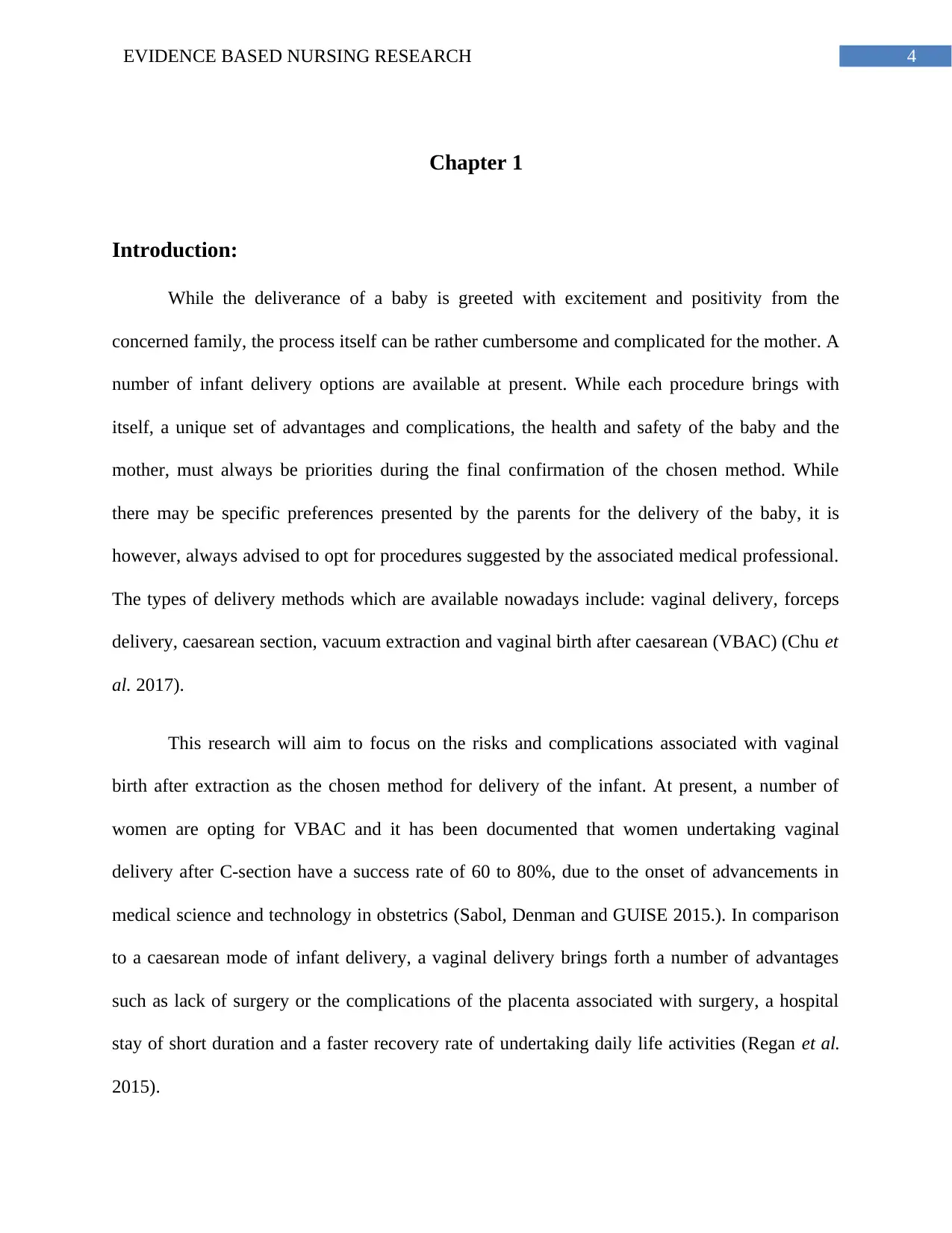
4EVIDENCE BASED NURSING RESEARCH
Chapter 1
Introduction:
While the deliverance of a baby is greeted with excitement and positivity from the
concerned family, the process itself can be rather cumbersome and complicated for the mother. A
number of infant delivery options are available at present. While each procedure brings with
itself, a unique set of advantages and complications, the health and safety of the baby and the
mother, must always be priorities during the final confirmation of the chosen method. While
there may be specific preferences presented by the parents for the delivery of the baby, it is
however, always advised to opt for procedures suggested by the associated medical professional.
The types of delivery methods which are available nowadays include: vaginal delivery, forceps
delivery, caesarean section, vacuum extraction and vaginal birth after caesarean (VBAC) (Chu et
al. 2017).
This research will aim to focus on the risks and complications associated with vaginal
birth after extraction as the chosen method for delivery of the infant. At present, a number of
women are opting for VBAC and it has been documented that women undertaking vaginal
delivery after C-section have a success rate of 60 to 80%, due to the onset of advancements in
medical science and technology in obstetrics (Sabol, Denman and GUISE 2015.). In comparison
to a caesarean mode of infant delivery, a vaginal delivery brings forth a number of advantages
such as lack of surgery or the complications of the placenta associated with surgery, a hospital
stay of short duration and a faster recovery rate of undertaking daily life activities (Regan et al.
2015).
Chapter 1
Introduction:
While the deliverance of a baby is greeted with excitement and positivity from the
concerned family, the process itself can be rather cumbersome and complicated for the mother. A
number of infant delivery options are available at present. While each procedure brings with
itself, a unique set of advantages and complications, the health and safety of the baby and the
mother, must always be priorities during the final confirmation of the chosen method. While
there may be specific preferences presented by the parents for the delivery of the baby, it is
however, always advised to opt for procedures suggested by the associated medical professional.
The types of delivery methods which are available nowadays include: vaginal delivery, forceps
delivery, caesarean section, vacuum extraction and vaginal birth after caesarean (VBAC) (Chu et
al. 2017).
This research will aim to focus on the risks and complications associated with vaginal
birth after extraction as the chosen method for delivery of the infant. At present, a number of
women are opting for VBAC and it has been documented that women undertaking vaginal
delivery after C-section have a success rate of 60 to 80%, due to the onset of advancements in
medical science and technology in obstetrics (Sabol, Denman and GUISE 2015.). In comparison
to a caesarean mode of infant delivery, a vaginal delivery brings forth a number of advantages
such as lack of surgery or the complications of the placenta associated with surgery, a hospital
stay of short duration and a faster recovery rate of undertaking daily life activities (Regan et al.
2015).
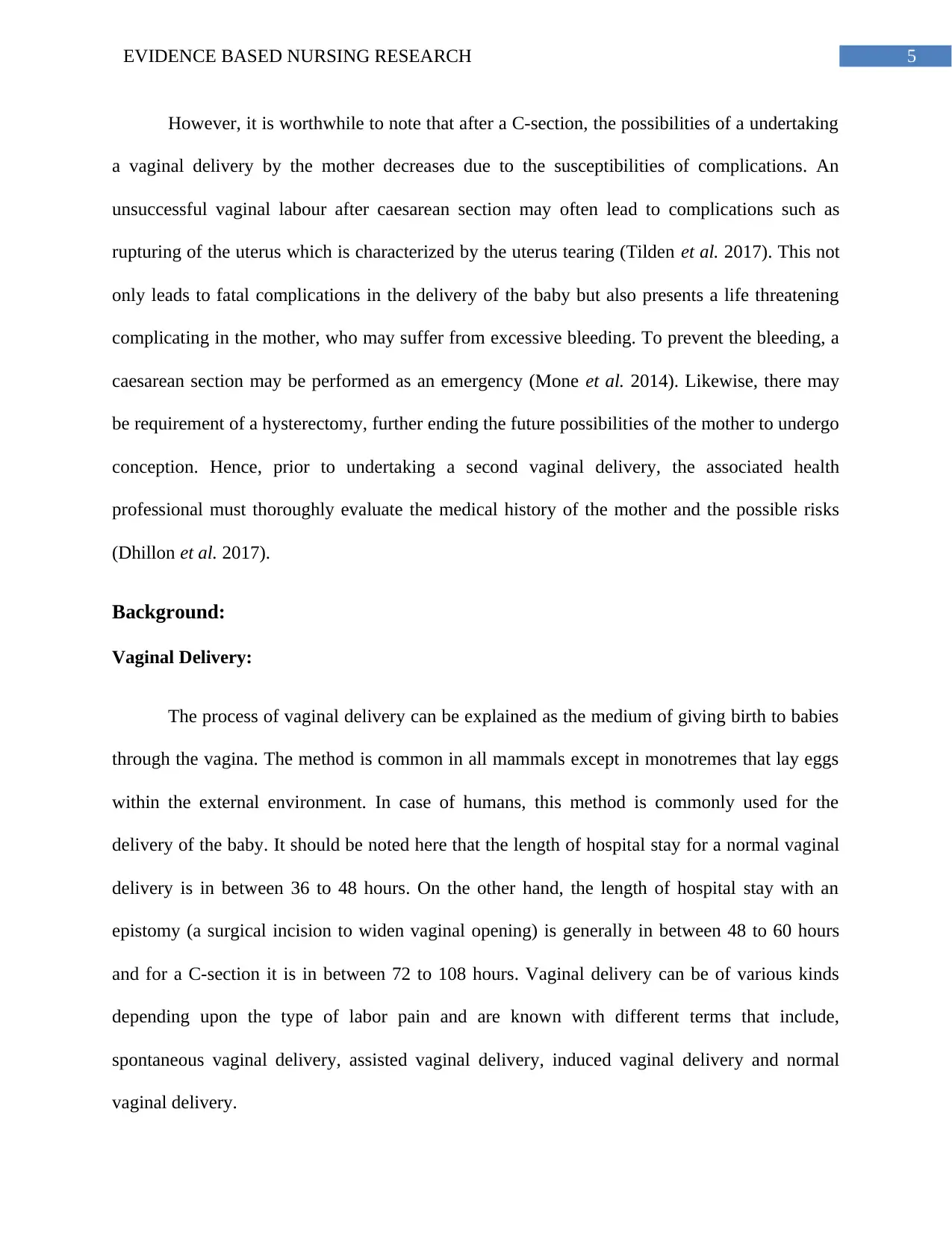
5EVIDENCE BASED NURSING RESEARCH
However, it is worthwhile to note that after a C-section, the possibilities of a undertaking
a vaginal delivery by the mother decreases due to the susceptibilities of complications. An
unsuccessful vaginal labour after caesarean section may often lead to complications such as
rupturing of the uterus which is characterized by the uterus tearing (Tilden et al. 2017). This not
only leads to fatal complications in the delivery of the baby but also presents a life threatening
complicating in the mother, who may suffer from excessive bleeding. To prevent the bleeding, a
caesarean section may be performed as an emergency (Mone et al. 2014). Likewise, there may
be requirement of a hysterectomy, further ending the future possibilities of the mother to undergo
conception. Hence, prior to undertaking a second vaginal delivery, the associated health
professional must thoroughly evaluate the medical history of the mother and the possible risks
(Dhillon et al. 2017).
Background:
Vaginal Delivery:
The process of vaginal delivery can be explained as the medium of giving birth to babies
through the vagina. The method is common in all mammals except in monotremes that lay eggs
within the external environment. In case of humans, this method is commonly used for the
delivery of the baby. It should be noted here that the length of hospital stay for a normal vaginal
delivery is in between 36 to 48 hours. On the other hand, the length of hospital stay with an
epistomy (a surgical incision to widen vaginal opening) is generally in between 48 to 60 hours
and for a C-section it is in between 72 to 108 hours. Vaginal delivery can be of various kinds
depending upon the type of labor pain and are known with different terms that include,
spontaneous vaginal delivery, assisted vaginal delivery, induced vaginal delivery and normal
vaginal delivery.
However, it is worthwhile to note that after a C-section, the possibilities of a undertaking
a vaginal delivery by the mother decreases due to the susceptibilities of complications. An
unsuccessful vaginal labour after caesarean section may often lead to complications such as
rupturing of the uterus which is characterized by the uterus tearing (Tilden et al. 2017). This not
only leads to fatal complications in the delivery of the baby but also presents a life threatening
complicating in the mother, who may suffer from excessive bleeding. To prevent the bleeding, a
caesarean section may be performed as an emergency (Mone et al. 2014). Likewise, there may
be requirement of a hysterectomy, further ending the future possibilities of the mother to undergo
conception. Hence, prior to undertaking a second vaginal delivery, the associated health
professional must thoroughly evaluate the medical history of the mother and the possible risks
(Dhillon et al. 2017).
Background:
Vaginal Delivery:
The process of vaginal delivery can be explained as the medium of giving birth to babies
through the vagina. The method is common in all mammals except in monotremes that lay eggs
within the external environment. In case of humans, this method is commonly used for the
delivery of the baby. It should be noted here that the length of hospital stay for a normal vaginal
delivery is in between 36 to 48 hours. On the other hand, the length of hospital stay with an
epistomy (a surgical incision to widen vaginal opening) is generally in between 48 to 60 hours
and for a C-section it is in between 72 to 108 hours. Vaginal delivery can be of various kinds
depending upon the type of labor pain and are known with different terms that include,
spontaneous vaginal delivery, assisted vaginal delivery, induced vaginal delivery and normal
vaginal delivery.
⊘ This is a preview!⊘
Do you want full access?
Subscribe today to unlock all pages.

Trusted by 1+ million students worldwide
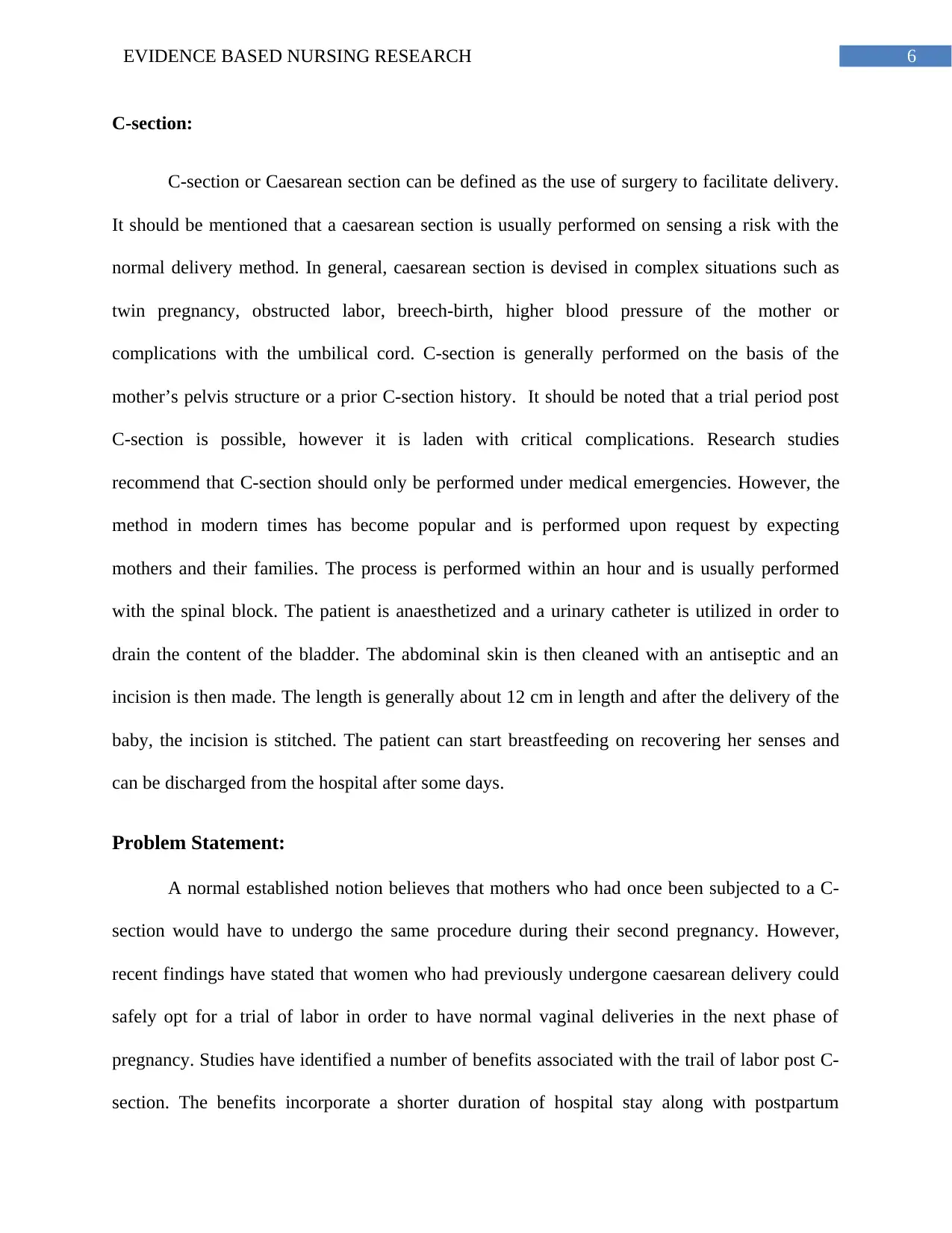
6EVIDENCE BASED NURSING RESEARCH
C-section:
C-section or Caesarean section can be defined as the use of surgery to facilitate delivery.
It should be mentioned that a caesarean section is usually performed on sensing a risk with the
normal delivery method. In general, caesarean section is devised in complex situations such as
twin pregnancy, obstructed labor, breech-birth, higher blood pressure of the mother or
complications with the umbilical cord. C-section is generally performed on the basis of the
mother’s pelvis structure or a prior C-section history. It should be noted that a trial period post
C-section is possible, however it is laden with critical complications. Research studies
recommend that C-section should only be performed under medical emergencies. However, the
method in modern times has become popular and is performed upon request by expecting
mothers and their families. The process is performed within an hour and is usually performed
with the spinal block. The patient is anaesthetized and a urinary catheter is utilized in order to
drain the content of the bladder. The abdominal skin is then cleaned with an antiseptic and an
incision is then made. The length is generally about 12 cm in length and after the delivery of the
baby, the incision is stitched. The patient can start breastfeeding on recovering her senses and
can be discharged from the hospital after some days.
Problem Statement:
A normal established notion believes that mothers who had once been subjected to a C-
section would have to undergo the same procedure during their second pregnancy. However,
recent findings have stated that women who had previously undergone caesarean delivery could
safely opt for a trial of labor in order to have normal vaginal deliveries in the next phase of
pregnancy. Studies have identified a number of benefits associated with the trail of labor post C-
section. The benefits incorporate a shorter duration of hospital stay along with postpartum
C-section:
C-section or Caesarean section can be defined as the use of surgery to facilitate delivery.
It should be mentioned that a caesarean section is usually performed on sensing a risk with the
normal delivery method. In general, caesarean section is devised in complex situations such as
twin pregnancy, obstructed labor, breech-birth, higher blood pressure of the mother or
complications with the umbilical cord. C-section is generally performed on the basis of the
mother’s pelvis structure or a prior C-section history. It should be noted that a trial period post
C-section is possible, however it is laden with critical complications. Research studies
recommend that C-section should only be performed under medical emergencies. However, the
method in modern times has become popular and is performed upon request by expecting
mothers and their families. The process is performed within an hour and is usually performed
with the spinal block. The patient is anaesthetized and a urinary catheter is utilized in order to
drain the content of the bladder. The abdominal skin is then cleaned with an antiseptic and an
incision is then made. The length is generally about 12 cm in length and after the delivery of the
baby, the incision is stitched. The patient can start breastfeeding on recovering her senses and
can be discharged from the hospital after some days.
Problem Statement:
A normal established notion believes that mothers who had once been subjected to a C-
section would have to undergo the same procedure during their second pregnancy. However,
recent findings have stated that women who had previously undergone caesarean delivery could
safely opt for a trial of labor in order to have normal vaginal deliveries in the next phase of
pregnancy. Studies have identified a number of benefits associated with the trail of labor post C-
section. The benefits incorporate a shorter duration of hospital stay along with postpartum
Paraphrase This Document
Need a fresh take? Get an instant paraphrase of this document with our AI Paraphraser
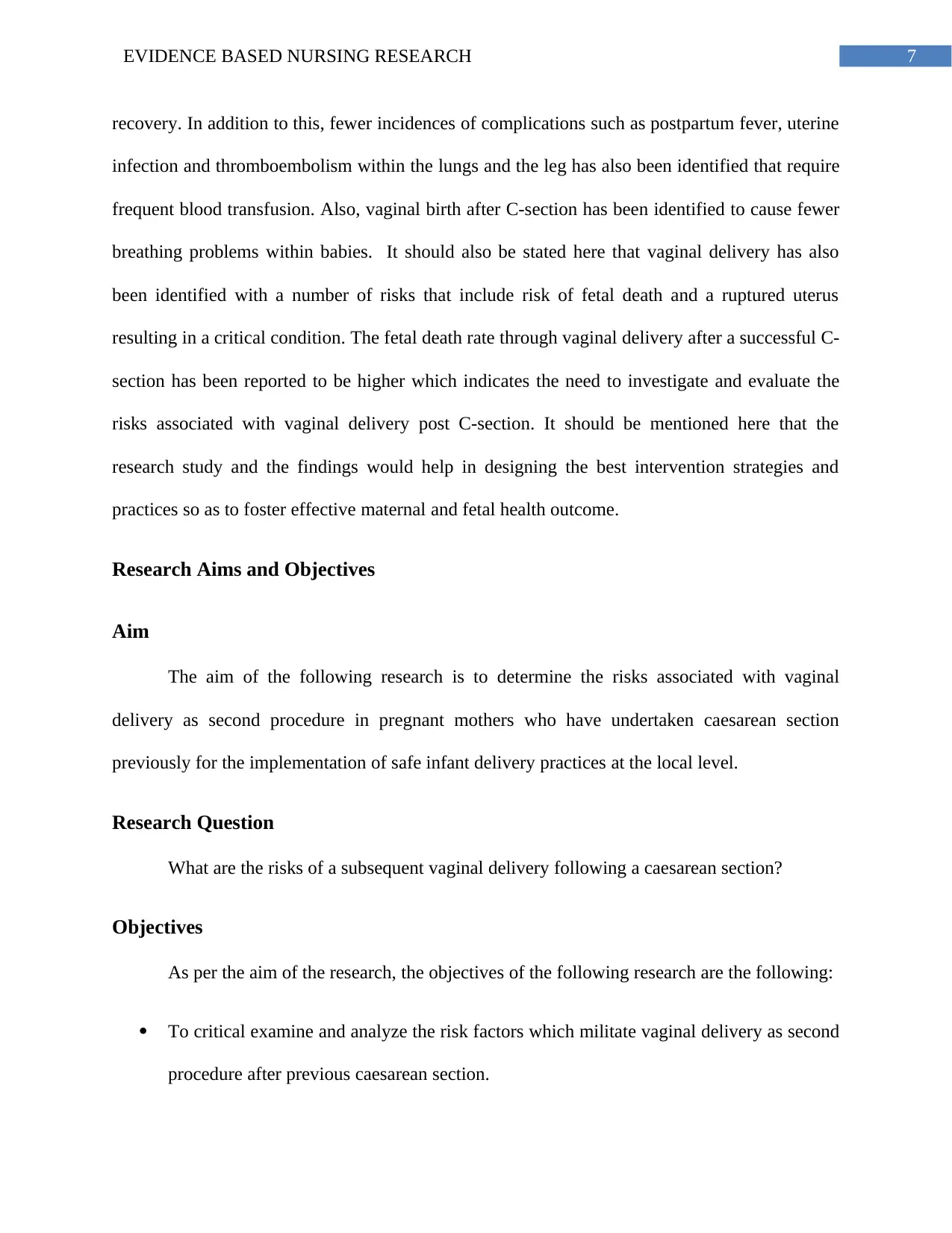
7EVIDENCE BASED NURSING RESEARCH
recovery. In addition to this, fewer incidences of complications such as postpartum fever, uterine
infection and thromboembolism within the lungs and the leg has also been identified that require
frequent blood transfusion. Also, vaginal birth after C-section has been identified to cause fewer
breathing problems within babies. It should also be stated here that vaginal delivery has also
been identified with a number of risks that include risk of fetal death and a ruptured uterus
resulting in a critical condition. The fetal death rate through vaginal delivery after a successful C-
section has been reported to be higher which indicates the need to investigate and evaluate the
risks associated with vaginal delivery post C-section. It should be mentioned here that the
research study and the findings would help in designing the best intervention strategies and
practices so as to foster effective maternal and fetal health outcome.
Research Aims and Objectives
Aim
The aim of the following research is to determine the risks associated with vaginal
delivery as second procedure in pregnant mothers who have undertaken caesarean section
previously for the implementation of safe infant delivery practices at the local level.
Research Question
What are the risks of a subsequent vaginal delivery following a caesarean section?
Objectives
As per the aim of the research, the objectives of the following research are the following:
To critical examine and analyze the risk factors which militate vaginal delivery as second
procedure after previous caesarean section.
recovery. In addition to this, fewer incidences of complications such as postpartum fever, uterine
infection and thromboembolism within the lungs and the leg has also been identified that require
frequent blood transfusion. Also, vaginal birth after C-section has been identified to cause fewer
breathing problems within babies. It should also be stated here that vaginal delivery has also
been identified with a number of risks that include risk of fetal death and a ruptured uterus
resulting in a critical condition. The fetal death rate through vaginal delivery after a successful C-
section has been reported to be higher which indicates the need to investigate and evaluate the
risks associated with vaginal delivery post C-section. It should be mentioned here that the
research study and the findings would help in designing the best intervention strategies and
practices so as to foster effective maternal and fetal health outcome.
Research Aims and Objectives
Aim
The aim of the following research is to determine the risks associated with vaginal
delivery as second procedure in pregnant mothers who have undertaken caesarean section
previously for the implementation of safe infant delivery practices at the local level.
Research Question
What are the risks of a subsequent vaginal delivery following a caesarean section?
Objectives
As per the aim of the research, the objectives of the following research are the following:
To critical examine and analyze the risk factors which militate vaginal delivery as second
procedure after previous caesarean section.
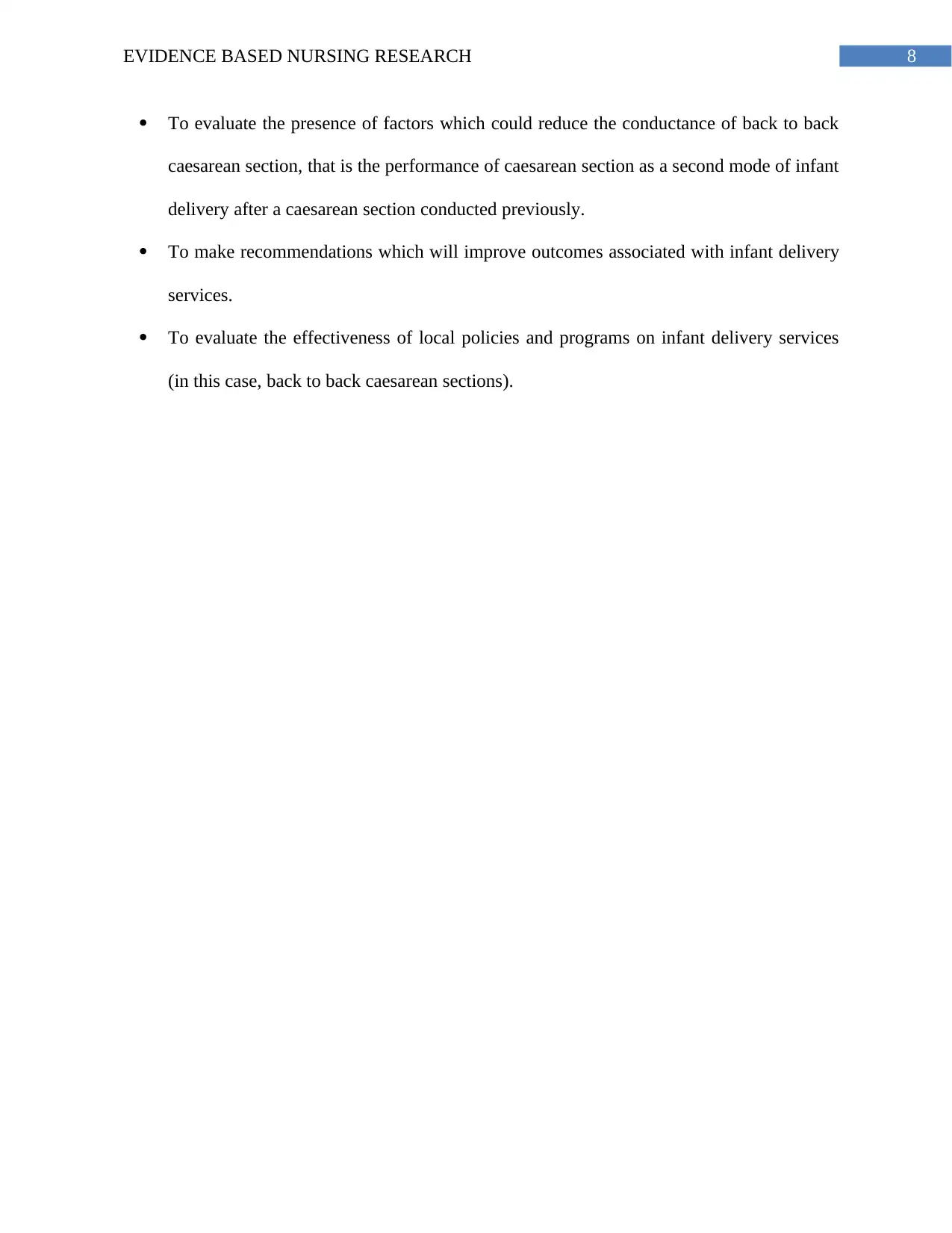
8EVIDENCE BASED NURSING RESEARCH
To evaluate the presence of factors which could reduce the conductance of back to back
caesarean section, that is the performance of caesarean section as a second mode of infant
delivery after a caesarean section conducted previously.
To make recommendations which will improve outcomes associated with infant delivery
services.
To evaluate the effectiveness of local policies and programs on infant delivery services
(in this case, back to back caesarean sections).
To evaluate the presence of factors which could reduce the conductance of back to back
caesarean section, that is the performance of caesarean section as a second mode of infant
delivery after a caesarean section conducted previously.
To make recommendations which will improve outcomes associated with infant delivery
services.
To evaluate the effectiveness of local policies and programs on infant delivery services
(in this case, back to back caesarean sections).
⊘ This is a preview!⊘
Do you want full access?
Subscribe today to unlock all pages.

Trusted by 1+ million students worldwide
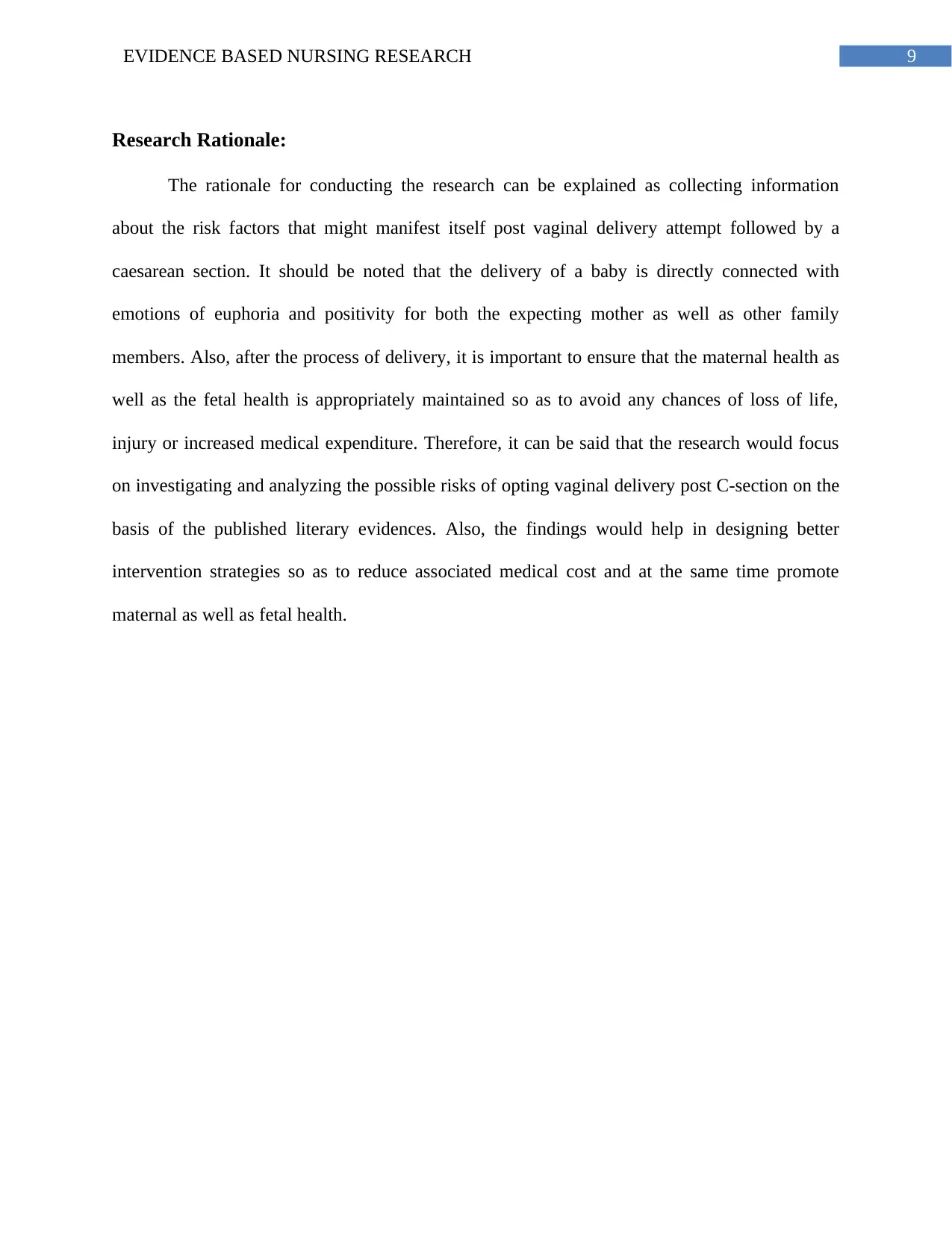
9EVIDENCE BASED NURSING RESEARCH
Research Rationale:
The rationale for conducting the research can be explained as collecting information
about the risk factors that might manifest itself post vaginal delivery attempt followed by a
caesarean section. It should be noted that the delivery of a baby is directly connected with
emotions of euphoria and positivity for both the expecting mother as well as other family
members. Also, after the process of delivery, it is important to ensure that the maternal health as
well as the fetal health is appropriately maintained so as to avoid any chances of loss of life,
injury or increased medical expenditure. Therefore, it can be said that the research would focus
on investigating and analyzing the possible risks of opting vaginal delivery post C-section on the
basis of the published literary evidences. Also, the findings would help in designing better
intervention strategies so as to reduce associated medical cost and at the same time promote
maternal as well as fetal health.
Research Rationale:
The rationale for conducting the research can be explained as collecting information
about the risk factors that might manifest itself post vaginal delivery attempt followed by a
caesarean section. It should be noted that the delivery of a baby is directly connected with
emotions of euphoria and positivity for both the expecting mother as well as other family
members. Also, after the process of delivery, it is important to ensure that the maternal health as
well as the fetal health is appropriately maintained so as to avoid any chances of loss of life,
injury or increased medical expenditure. Therefore, it can be said that the research would focus
on investigating and analyzing the possible risks of opting vaginal delivery post C-section on the
basis of the published literary evidences. Also, the findings would help in designing better
intervention strategies so as to reduce associated medical cost and at the same time promote
maternal as well as fetal health.
Paraphrase This Document
Need a fresh take? Get an instant paraphrase of this document with our AI Paraphraser
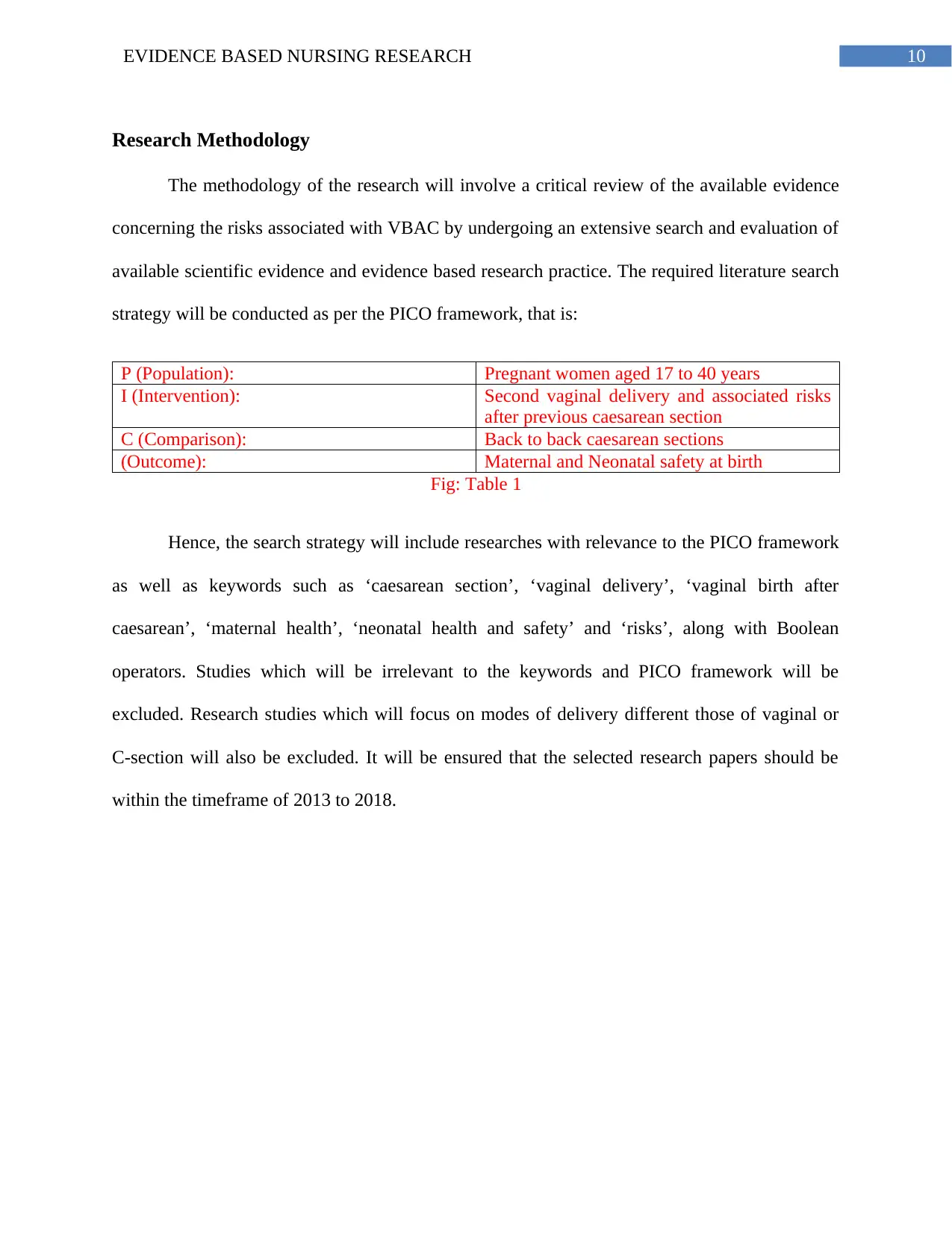
10EVIDENCE BASED NURSING RESEARCH
Research Methodology
The methodology of the research will involve a critical review of the available evidence
concerning the risks associated with VBAC by undergoing an extensive search and evaluation of
available scientific evidence and evidence based research practice. The required literature search
strategy will be conducted as per the PICO framework, that is:
P (Population): Pregnant women aged 17 to 40 years
I (Intervention): Second vaginal delivery and associated risks
after previous caesarean section
C (Comparison): Back to back caesarean sections
(Outcome): Maternal and Neonatal safety at birth
Fig: Table 1
Hence, the search strategy will include researches with relevance to the PICO framework
as well as keywords such as ‘caesarean section’, ‘vaginal delivery’, ‘vaginal birth after
caesarean’, ‘maternal health’, ‘neonatal health and safety’ and ‘risks’, along with Boolean
operators. Studies which will be irrelevant to the keywords and PICO framework will be
excluded. Research studies which will focus on modes of delivery different those of vaginal or
C-section will also be excluded. It will be ensured that the selected research papers should be
within the timeframe of 2013 to 2018.
Research Methodology
The methodology of the research will involve a critical review of the available evidence
concerning the risks associated with VBAC by undergoing an extensive search and evaluation of
available scientific evidence and evidence based research practice. The required literature search
strategy will be conducted as per the PICO framework, that is:
P (Population): Pregnant women aged 17 to 40 years
I (Intervention): Second vaginal delivery and associated risks
after previous caesarean section
C (Comparison): Back to back caesarean sections
(Outcome): Maternal and Neonatal safety at birth
Fig: Table 1
Hence, the search strategy will include researches with relevance to the PICO framework
as well as keywords such as ‘caesarean section’, ‘vaginal delivery’, ‘vaginal birth after
caesarean’, ‘maternal health’, ‘neonatal health and safety’ and ‘risks’, along with Boolean
operators. Studies which will be irrelevant to the keywords and PICO framework will be
excluded. Research studies which will focus on modes of delivery different those of vaginal or
C-section will also be excluded. It will be ensured that the selected research papers should be
within the timeframe of 2013 to 2018.
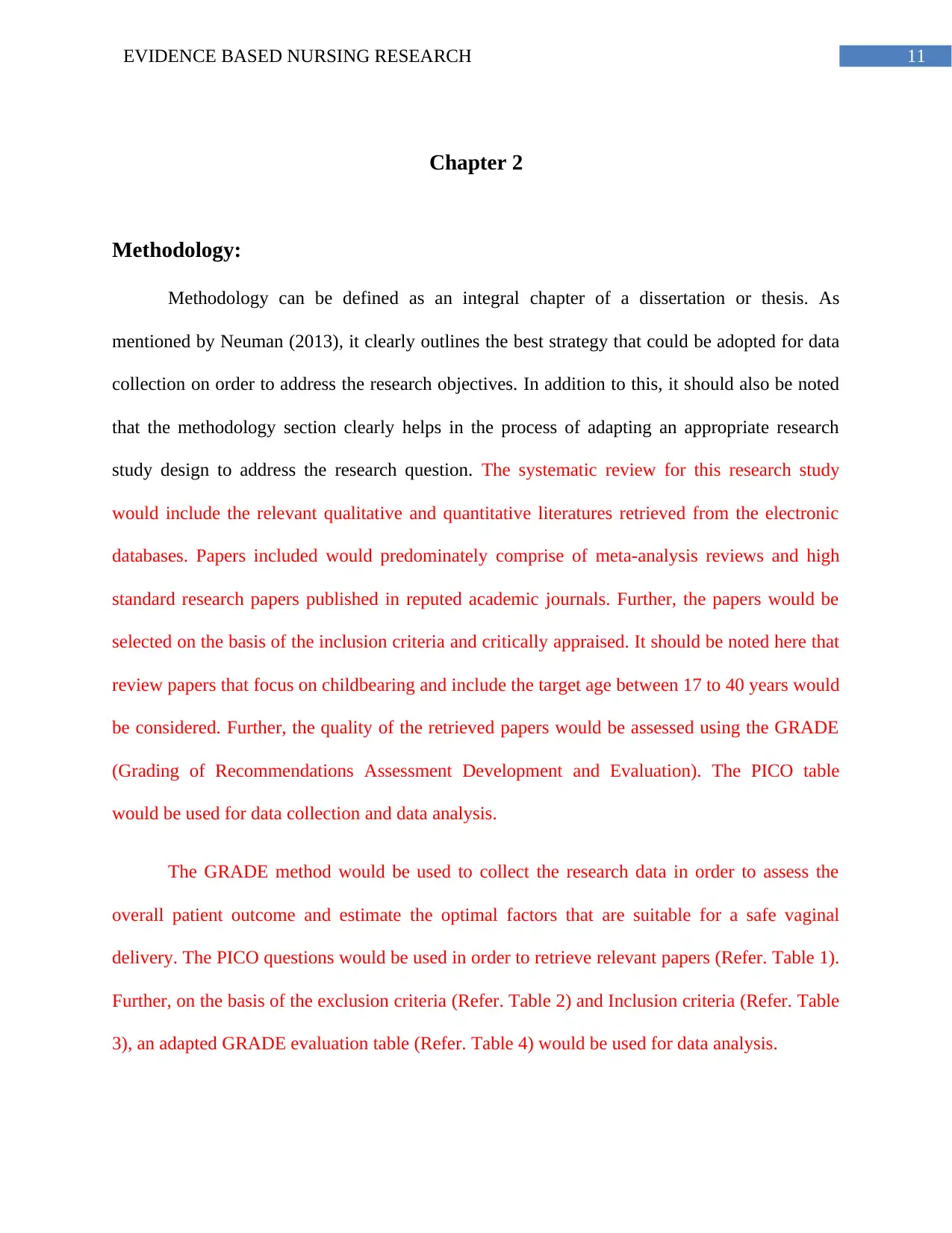
11EVIDENCE BASED NURSING RESEARCH
Chapter 2
Methodology:
Methodology can be defined as an integral chapter of a dissertation or thesis. As
mentioned by Neuman (2013), it clearly outlines the best strategy that could be adopted for data
collection on order to address the research objectives. In addition to this, it should also be noted
that the methodology section clearly helps in the process of adapting an appropriate research
study design to address the research question. The systematic review for this research study
would include the relevant qualitative and quantitative literatures retrieved from the electronic
databases. Papers included would predominately comprise of meta-analysis reviews and high
standard research papers published in reputed academic journals. Further, the papers would be
selected on the basis of the inclusion criteria and critically appraised. It should be noted here that
review papers that focus on childbearing and include the target age between 17 to 40 years would
be considered. Further, the quality of the retrieved papers would be assessed using the GRADE
(Grading of Recommendations Assessment Development and Evaluation). The PICO table
would be used for data collection and data analysis.
The GRADE method would be used to collect the research data in order to assess the
overall patient outcome and estimate the optimal factors that are suitable for a safe vaginal
delivery. The PICO questions would be used in order to retrieve relevant papers (Refer. Table 1).
Further, on the basis of the exclusion criteria (Refer. Table 2) and Inclusion criteria (Refer. Table
3), an adapted GRADE evaluation table (Refer. Table 4) would be used for data analysis.
Chapter 2
Methodology:
Methodology can be defined as an integral chapter of a dissertation or thesis. As
mentioned by Neuman (2013), it clearly outlines the best strategy that could be adopted for data
collection on order to address the research objectives. In addition to this, it should also be noted
that the methodology section clearly helps in the process of adapting an appropriate research
study design to address the research question. The systematic review for this research study
would include the relevant qualitative and quantitative literatures retrieved from the electronic
databases. Papers included would predominately comprise of meta-analysis reviews and high
standard research papers published in reputed academic journals. Further, the papers would be
selected on the basis of the inclusion criteria and critically appraised. It should be noted here that
review papers that focus on childbearing and include the target age between 17 to 40 years would
be considered. Further, the quality of the retrieved papers would be assessed using the GRADE
(Grading of Recommendations Assessment Development and Evaluation). The PICO table
would be used for data collection and data analysis.
The GRADE method would be used to collect the research data in order to assess the
overall patient outcome and estimate the optimal factors that are suitable for a safe vaginal
delivery. The PICO questions would be used in order to retrieve relevant papers (Refer. Table 1).
Further, on the basis of the exclusion criteria (Refer. Table 2) and Inclusion criteria (Refer. Table
3), an adapted GRADE evaluation table (Refer. Table 4) would be used for data analysis.
⊘ This is a preview!⊘
Do you want full access?
Subscribe today to unlock all pages.

Trusted by 1+ million students worldwide
1 out of 51
Related Documents
Your All-in-One AI-Powered Toolkit for Academic Success.
+13062052269
info@desklib.com
Available 24*7 on WhatsApp / Email
![[object Object]](/_next/static/media/star-bottom.7253800d.svg)
Unlock your academic potential
Copyright © 2020–2025 A2Z Services. All Rights Reserved. Developed and managed by ZUCOL.





